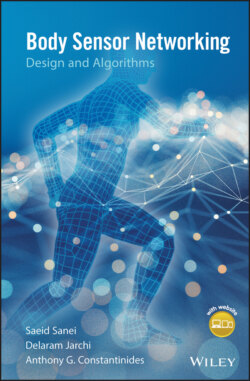Читать книгу Body Sensor Networking, Design and Algorithms - Saeid Sanei - Страница 19
2.4 Biological State of Human Body
ОглавлениеBiology is a general term which describes various organs of living organisms, including human, and their behaviour starting from biochemical reactions in tissue molecules and tissue cell behaviour in circulatory, respiratory, and nervous systems.
Current techniques in system biology focus on complex interactions within biological systems, using a holistic approach to biological research. One of the aims of systems biology is to model and discover emergent properties of cells, tissues, and organisms, collectively functioning as a system, whose theoretical description is only possible using techniques which fall under the remit of systems biology [13]. These typically involve metabolic or cell signalling networks [14] available in all live human organs.
Biological abnormalities refer to either genetic disorders, which may cause secondary problems, or infectious, bacterial, and immunodeficiency diseases. Tuberculosis, cholera, malaria, and AIDS as one of the deadliest one caused by the human immunodeficiency virus (HIV) are some examples of biological diseases.
Genetic disorders are caused by point mutation or gene damage due to insertion or deletion of a gene bond, deletion of a gene or genes, missing chromosomes, or trinucleotide repeat disorder. There are many types of such disorders, including colour blindness, cystic fibrosis, Down syndrome, haemophilia, neurofibromatosis, polycystic kidney disease, and spinal muscular atrophy.
Monitoring the human body for diseases often starts from noninvasive examinations and data recordings followed by taking and testing blood or urine samples. In the later stages, however, invasive tissue sampling by means of biopsy or various imaging modalities may become necessary. As an example, for monitoring a tumour in the body, the examination may be extended to biopsy operation and radiography to enable accurate diagnosis.
A class of biological diseases called autoimmune diseases are among the top mortality causes according to the American Autoimmune Related Diseases Association (AARDA). These diseases are the result of an abnormal immune response of the body against substances and tissues normally present in the body [15]. To diagnose autoimmune diseases, high resolution imaging of the affected organ through indirect immunofluorescence (IIF) is needed. IIF is an imaging technique that captures images of human epithelial type-2 (HEp-2) cells [16]. Using this imaging technique, antinuclear antibody (ANA), a type of autoantibody binding to the contents of the cell nucleus, is considered a hallmark of autoimmune diseases.
In the IIF test, antibodies are first stained in HEp-2 tissue and then bound to a fluorescent chemical compound. In the cells containing ANAs, the antibodies bound to the nucleus demonstrate different patterns that can be captured and seen via microscope imaging. Categorising the patterns in the HEp-2 cell images can be used to distinguish the phase and severity of autoimmune diseases [17]. The IIF imaging test consists of five different stages [18] where the first stage is autofocus image acquisition to reduce photobleaching effects [19]. The second stage is automatic segmentation of the cells using methods such as the similarity-based watershed and adaptive edge-based segmentation [20, 21]. This is followed by the mitotic cell segmentation using morphological and textural features and local binary patterns (LBPs) [22]. In the fourth stage, the intensity level images are classified into three classes of negative, intermediate, and positive intensities [23]. Finally, the cell staining patterns are classified into centromere (Ce), coarse-speckled (Cs), cytoplasmatic (Cy), fine-speckled (Fs), homogeneous (H), nucleolar (N), and Golgi (G), corresponding to different types of autoimmune diseases.
Computer-aided diagnosis (CAD) systems, developed by engineers and computer scientists for automatic classification of HEp-2 cells, have attracted much interest in the diagnosis of autoimmune diseases. The systems reduce the cost and time of the diagnosis process and provide repeatability of the test for different physicians.
